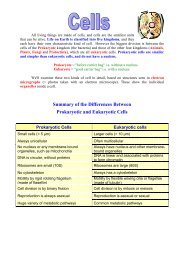Nerve Impulses - BiologyMad A-Level Biology
Nerve Impulses - BiologyMad A-Level Biology
Nerve Impulses - BiologyMad A-Level Biology
Create successful ePaper yourself
Turn your PDF publications into a flip-book with our unique Google optimized e-Paper software.
<strong>Nerve</strong> <strong>Impulses</strong><br />
Neurones send messages electrochemically, what does this mean?<br />
………………………………………………………………………………………………………………………………<br />
……..………………………………………………………………………………………………………………………<br />
……………..………………………………………………………………………………………………………………<br />
……………..………………………………………………………………………………………………………………<br />
Resting Membrane Potential<br />
How do the following diagrams help explain resting membrane potential?<br />
outside<br />
cell<br />
membrane<br />
inside<br />
3Na +<br />
Na + +<br />
Na K ATPase K<br />
closed<br />
(leak)<br />
ATP ADP+P i<br />
2K +<br />
closed<br />
(leak)<br />
………………………………………………………………………………………………………………………………<br />
……..………………………………………………………………………………………………………………………<br />
……………..………………………………………………………………………………………………………………<br />
……………………..………………………………………………………………………………………………………<br />
……………………………..………………………………………………………………………………………………<br />
……………………………………..………………………………………………………………………………………<br />
……………………………………………..………………………………………………………………………………<br />
……………………………………………………..………………………………………………………………………<br />
……………………………………………………………..………………………………………………………………<br />
……………………………………………………………………..………………………………………………………<br />
……………………………………………………………………………..………………………………………………<br />
…………………………………………………………………………………………………………………………….<br />
What is an axons resting potential? ……………..……………………………………………<br />
<strong><strong>Biology</strong>Mad</strong>.com<br />
+<br />
-
Action Potential<br />
What is an action potential? ……………………………………………………………………………………….….<br />
……………………..………………………………………………………………………………………………………<br />
……………………..………………………………………………………………………………………………………<br />
……………………..………………………………………………………………………………………………………<br />
……………………..………………………………………………………………………………………………………<br />
Use the diagrams below to explain the following terms:<br />
Depolarisation: ……………..……………………………………..………<br />
……………………………………………………………………………...<br />
……………………………………………………………………………...<br />
……………………………………………………………………………...<br />
……………………………………………………………………………...<br />
……………………………………………………………………………...<br />
Repolarisation: : ……………..……………………………………..………<br />
……………………………………………………………………………...<br />
……………………………………………………………………………...<br />
……………………………………………………………………………...<br />
……………………………………………………………………………...<br />
……………………………………………………………………………...<br />
out<br />
in<br />
out<br />
in<br />
Na<br />
Na +<br />
Na<br />
open<br />
closed<br />
(leak)<br />
K<br />
closed<br />
(leak)<br />
Explain the ‘all or nothing event’ ……………………………………………………………………………………..…<br />
……………………………………………………………………………………………………………………………..<br />
…………………………………………………………………………………………………..…………………………<br />
What is the refractory period? ……………………………………………………………..…………………………..<br />
How do <strong>Nerve</strong> <strong>Impulses</strong> Start?<br />
……………..………………………………………………………………………………………………………………<br />
…………………………………………………………………………………………………..…………………………<br />
…………………………………………………………………………………………………..…………………………<br />
<strong><strong>Biology</strong>Mad</strong>.com<br />
K<br />
open<br />
K +<br />
-<br />
+<br />
+<br />
-
…………………………………………………………………………………………………..…………………………<br />
…………………………………………………………………………………………………..…………………………<br />
Summary of the Action Potential<br />
Cut out the statements and match them up to the correct picture<br />
<strong><strong>Biology</strong>Mad</strong>.com<br />
When stimulated past threshold, sodium channels<br />
open and sodium rushes into the axon, causing a<br />
region of positive charge within the axon.<br />
The sodium/potassium pump restores the resting<br />
concentrations of sodium and potassium ions<br />
At rest, the inside of the neuron is slightly negative<br />
due to a higher concentration of positively charged<br />
sodium ions outside the neuron.<br />
The region of positive charge causes nearby sodium<br />
channels to open. Just after the sodium channels<br />
close, the potassium channels open wide, and<br />
potassium exits the axon.<br />
This process continues as a chain-reaction along the<br />
axon. The influx of sodium depolarizes the axon,<br />
and the outflow of potassium repolarises the axon.
















